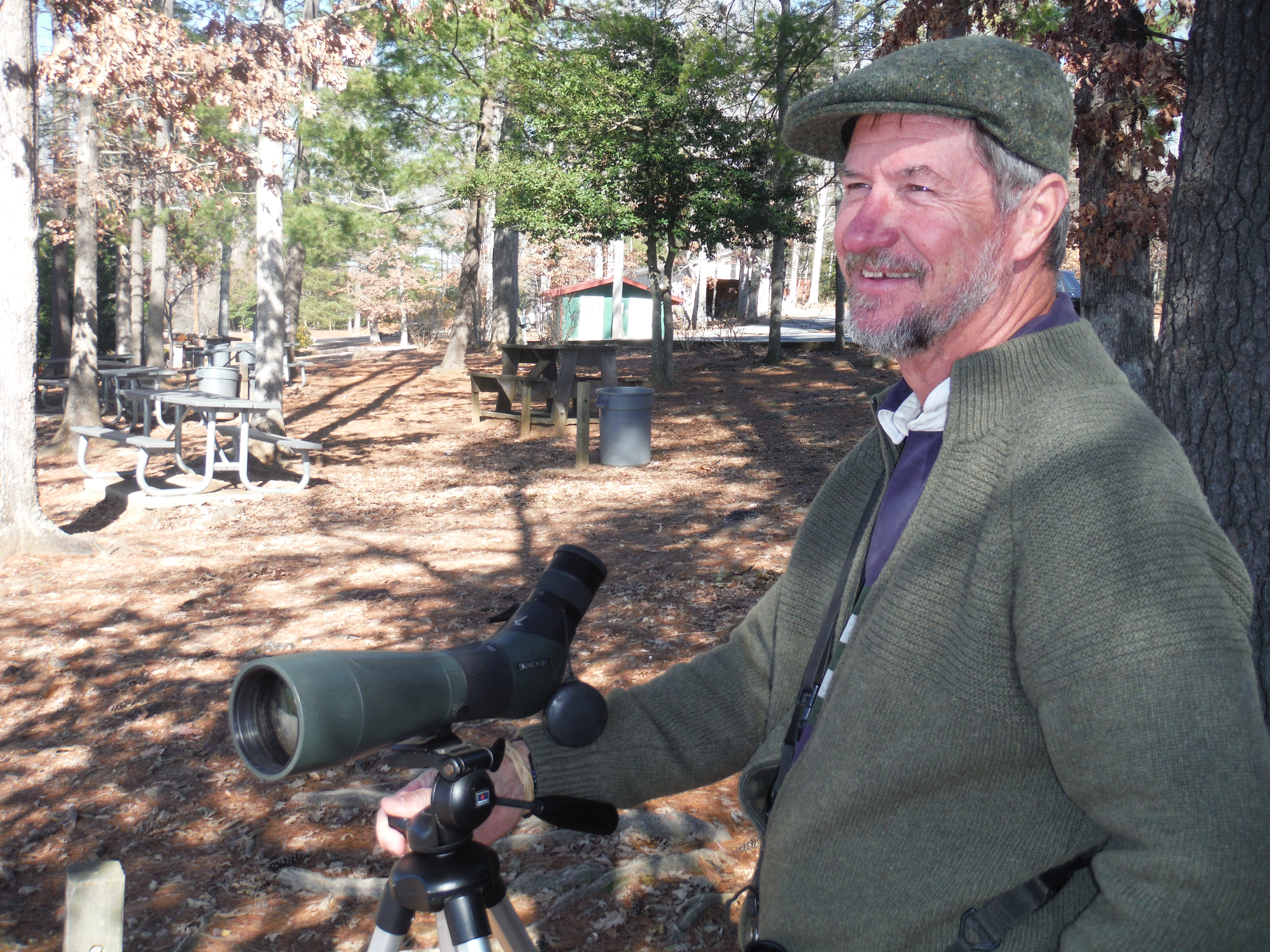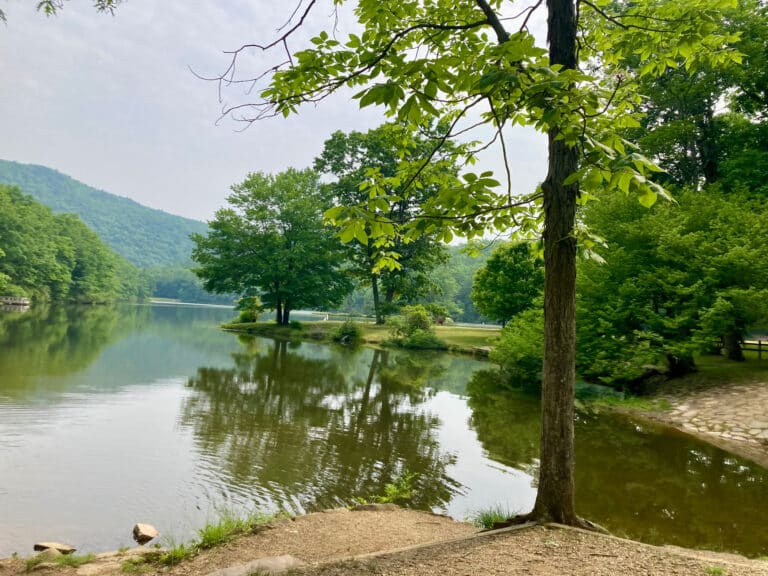When she learned that the tall man with the scruffy beard who had introduced himself merely as ‘Simon” was, in fact, Simon Thompson — globetrotting bird guide, possessor of a monster lifetime birding list, undisputed champion of a listing contest called Bird a Day — Leslie MacDuffie instantly morphed from birder to fan.
“I’m just delighted that I actually shook his hand today, to tell you the truth,” said McDuffie, of Waynesville. She was extra thrilled, she added, to learn that her online photo of a rare duck, the greater scaup, had lured Thompson to this spot, Lake Julian Park in Asheville. “That is so way cool, the fact that he recognized my name. … I always said I wanted to hobnob with Simon. Wait until my husband finds out. He’s going to be floored.”
Thompson, gracious but desperate to cap MacDuffie’s gusher, responded by peering through his scope at a winged silhouette on the opposite shore
“There’s a red-tailed hawk over there by the pines,” said Thompson, 57, of Asheville.
It’s his default mode, sighting birds, an activity he’s engaged in as prolifically and consistently (the key to his Bird a Day success) as just about anyone on the planet. A lifetime list of 500 bird species is the mark of a committed birder; 700 is the realm of fanatics willing to travel to obscure corners of North America. Among the birders on Cornell University’s eBird site — the go-to worldwide birding forum — Thompson’s list of 5,725 ranks him 27th. Once he completes the tedious task of entering all the birds from his several predigital decades as a birder, he said, the total will be at least 7,000, which would place him 8th.
The circumstance that stops him from competing for the absolute top spot — as the owner of Ventures Birding Tours, his first duty is to his clients rather than to his passion for birding — makes him a natural for Bird a Day.
This is one of several forms of listing, one more birding “game,” Thompson says, along with the more common big year or big day races to count the most birds in a given time period. It was initiated by the establishment of a website, birdaday.net in 2008. Since then, the number of entrants who met its self-explanatory challenge, sighting a different variety of bird every day of the year, has been, at most, a handful, and several years have passed without a single winner. Thompson, meanwhile, reached this goal three straight years, in 2015 and 2016 when he shared the distinction with other birders, and in 2017, when he was the only participant to last all 365 days.
“It’s an impressive thing because you have to be out every single day and you have to be able to identify a bird you had not previously listed,” said Bill Boeringer, a South Florida lawyer who unsuccessfully tried to revive the site late last year after the sudden death of its founder, Trey Mitchell. Bird a Day participants are temporarily keeping tabs of their own progress while hoping that a group of Australian birders build a new site.
“The Aussies seem particularly gung ho on this,” Boeringer said.
The trick of Bird a Day is to count as many rare and, especially, seasonal birds on good birding days early in the year, leaving a store of common species to tap into during lean periods.
“There’s inevitably going to come a rainy, nasty day when you want to be able to see that robin at your bird feeder from the comfort of your own kitchen,” said John Koon, a commercial airline pilot and Bird a Day regular from Asheville.
Most people have no hopes of lasting the year, Boeringer said.
“It’s like amateur golf: you are a winner if you exceed your own expectations. I work in an office; I cannot compete with people who are park naturalists, or are retired, etc. My “par” is making it to the first week of June.”
And because a limited number of bird species appear in most part of the country — about 250 in western North Carolina, for example — strategy and dedication can only get you so far.
“You have to travel,” Thompson said, and on this day in early January, his upcoming itinerary as a full-time guide and ex-pat Brit was as follows:
“I’m going to Georgia on Friday and then I’m taking a group to Virginia. Then I’m going to (Florida’s) Space Coast. Then I’m going to India and I’m coming back through Dubai and then I’ll go to England for a week or two.”
A similar routine in 2017 allowed him to squander birds he might normally hold in reserve — the turkey vulture, for example, that he recorded in October — because of the prospect of seeing, as he would, a jackass penguin in South Africa in November and a red-crested pochard on a trip to Spain in December. The only remotely dramatic event of last year’s contest came on a day when he was stranded at London’s Heathrow Airport and resorted to peering through windows to spot a runway-dwelling white wagtail.
Though normally self-effacing, Thompson acknowledged that a feat that had proven impossible for every other entrant was actually pretty easy for him.
“It was not a difficult year,” he said.
Still, he said, “I make the effort. It doesn’t happen without me trying.” And the aspect of Bird a Day he most appreciates, that it forces him to get out with his scope every day, is the one that led him to take a break from it in 2018. It’s a concession to his long-time partner and new husband, Chris Jaquette, and their caretaking obligations for sick friends and relatives.
But after all his Bird a Day success, it’s not an easy habit to break. He was keeping his options open and adhering to his usual strategy in case he decides on a late entry. “My start has always been, at the beginning of the year, go out and get those ducks,” he said.
And so he set up on the shores of Lake Julian, where a steam-belching Duke Energy plant makes for warm, ice-free water — a wintertime duck magnet.
Thompson admits he’s “a bit obsessive,” but he carries this obsession comfortably, and is so far removed from the stereotypical species-and-location spewing birder that he often can’t remember what he saw where. “I’ve been to Peru 18 times,” he said. “It becomes a bit of a blur.” He still sounds and looks — in a bulky cardigan, flat woolen cap and wide wale corduroy pants — distinctly British, even though he’s lived in Asheville for about 30 years. “I came to visit and I just stayed. I like it here.” Because of the surrounding National Forest, it’s also one of the few places where he’s seen little depreciation of habitat. He has watched this happen in Africa, where he grew up in what he describes as a birders’ paradise and started setting out with his binoculars as an 8-year-old boy. And though he’s heard enough hopeful reports about protection efforts in Chad and its rebounding elephant population to plan a trip there, he’s witnessed enough destruction of natural lands in other countries to make him think the peak era of global birding has probably passed. “In places like the Philippines and Indonesia it’s almost like an all-out war on the environment,” he said.
As engaging as Thompson is, when he’s in the field all conversations are interrupted conversations; his eyes and ears constantly wander for evidence for birds.
On, this, one of the first warm days of the year, he found the recently reported flotilla of ducks on the lake had vanished. But he took note of the semi-domesticated, feed-caging mallards and Muscovy ducks waddling on the shore. “Emergency Bird a Day birds,” he called them. “We’re quite disparaging, aren’t we?”
He identified slightly better birds, Carolina chickadees calling from branches and dark-eyed juncos feeding at the base of pine trees. He paused periodically to look through his top-of-the-line Swarovski scope for distant sightings of what he termed “good Bird a Day birds,” pintail ducks and American widgeons.
And when the time came to fold up his scope’s tripod, he was visibly disappointed that he had failed to see MacDuffie’s greater scaup.
“That would have been a great Bird a Day bird,” he said.








